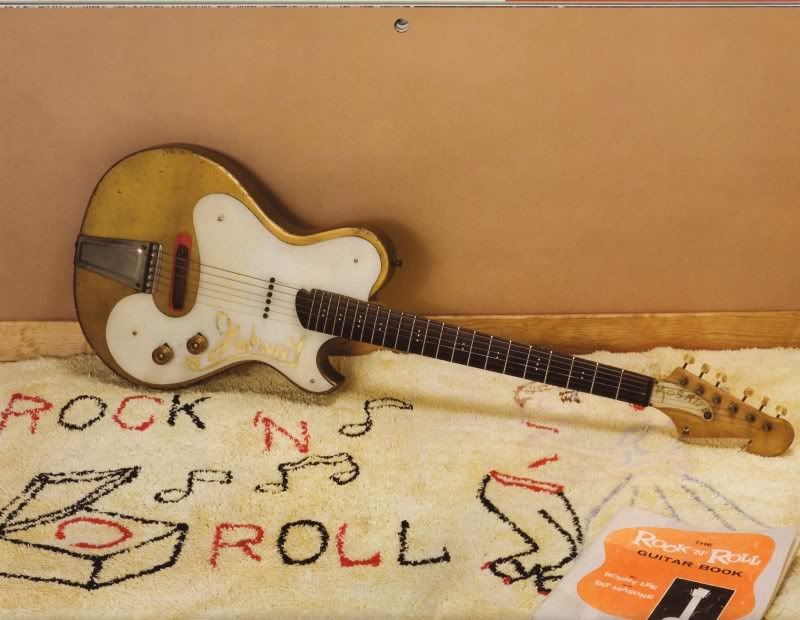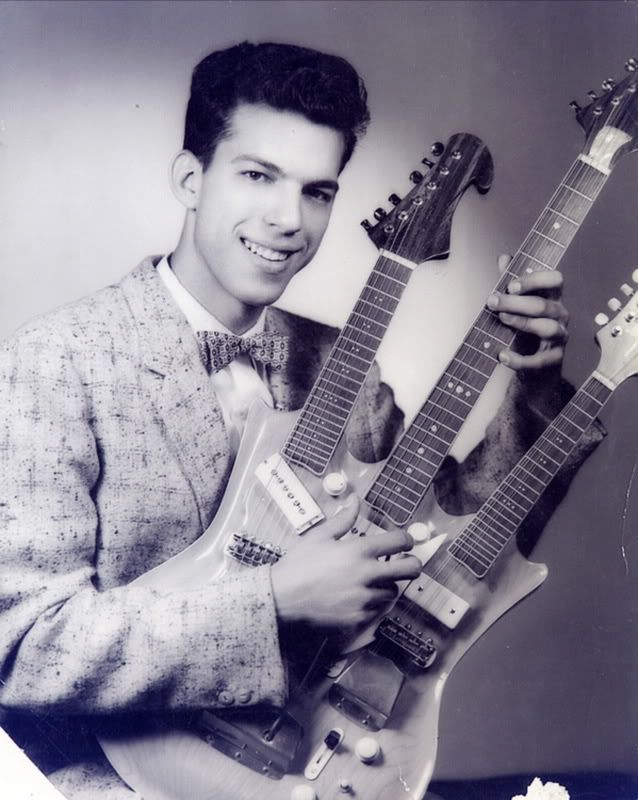As I mentioned, Semie began working for Paul Bigsby around 1952-1953, and after that association ended, he worked for Rickenbacker and studied under Roger Rossmeisl around 1954-1955.
Jay Rosen turned up this guitar a while back and put it in his yearly calendar. This image is owned and copyrighted by Jay Rosen.
Many people who have viewed this don't believe this really is a Mosrite, but I truly believe that this may be the earliest Mosrite guitar in existence. There are too many things that point to it being a real Mosrite circa the embryonic 1953-1954 era. First of all is the headstock, which is the Bigsby-esque headstock shape that Semie used for the first few years. He changed it to 3-on-a-side around 1956 because so many people kept thinking that they were Bigsby guitars.
Now, before looking at the next photo--check out that Semie created a 6-in-line headstock using the left and right hand tuners from a 3-on-a-plate Kluson tuners. See the space in between the D and G tuners?
The second thing that indicates to me that this is the genuine article is the trussrod cover. Although it is crude and has an almost child-like "mosrite" inscription on it, check out the shape--it's an almost complete ripoff of the Rickenbacker truss rod cover!
The third thing that makes me think this is the real deal is that it has a pickup (unknown if its a Carvin, perhaps it's a Gibson P-90 since it has Gibson knobs and tuners possibly stolen from a Gibson?) suspended in a floating one-piece pickguard assembly, like the 1958-1959 Mosrite that I posted on this forum the other day.
This thing is incredibly crude and shows little of the finesse that Semie later proved himself capable of. But I'm sticking my neck out here and saying this is the earliest Mosrite guitar known to exist.

Now, compare the "Johnny" guitar above to the earliest known photo of Semie with his custom made tripleneck guitar, circa 1953-1954. The most striking similarity is the headstock shape.
By this point Semie had learned the art of the German carve from Rickenbacker shop foreman Roger Rossmeisl. He had also started using the Carvin AP-6 pickups as his main pickup, and started making his bridges and tailpieces by hand.
Note also that this guitar, like the first incarnations of the Joe maphis & Larry Collins doublenecks, were blond wood with 6-on-a-side headstocks, like the Bigsby guitars that Semie had seen while working for Paul Bigsby.
Now, remember what I said about Semie using the left and right side of a 3-on-a-plate Kluson tuner set to make his 6-on-a-side? Look at the picture of Semie with the tripleneck and see the space in between the D and G tuners....the same tuner configuration as the "Johnny" guitar....a feature I've never seen on any other guitars....
Also note that the "Johnny" guitar and the Semie tripleneck upper and lower necks have the same tiny 3-dot pattern in the fingerboards. I think these two guitars were made right around the same time, at the very beginning of Mosrite.

This tripleneck guitar went through many "updates" and Semie was still playing it in the 1970's, but the story I heard is that it eventually met its final fate in the car accident that nearly killed Semie. Anybody else have a different story about the final resting place of Semie's tripleneck?
By 1956, Semie had switched to the 3-on-a-side headstocks and 3-color sunburst finishes that we now associate with Mosrite guitars. But these were the first!
Deke


